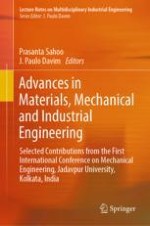2019 | Buch
Advances in Materials, Mechanical and Industrial Engineering
Selected Contributions from the First International Conference on Mechanical Engineering, Jadavpur University, Kolkata, India
herausgegeben von: Dr. Prasanta Sahoo, Prof. J. Paulo Davim
Verlag: Springer International Publishing
Buchreihe : Lecture Notes on Multidisciplinary Industrial Engineering
